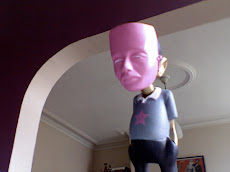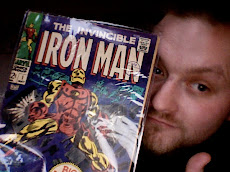


Highbrow lowbrow art
Nufonia Must Fall is probably the world's first comic by someone with a cartoon-character side persona. In this case, that would be Montreal DJ Kid Koala, probably best known for being part of the animated pop super-group Gorillaz.
And what a project Koala has turned in: a graphic novel that is 300-plus pages, almost entirely dialogue-free, and drawn in bleak charcoal hues. It's too bookish and highbrow to be a mere comic book, yet also too slapstick-y and hastily drawn to feel completely literary. In a world where Dave Sim and Alan Moore clearly try to bridge the gaps between the planes between pop art and something much more rarified, Koala's graphic novel seems to occupy a bizarre space in-between.
While Nufonia certainly isn't flawless for all its invention, the book is still strangely compelling when thumbed through quickly. (The entire thing can be devoured in no more than 15 minutes.)
Koala, whose real name is Eric San, has had a long-standing fascination with the sequential arts long before he allowed himself to be rendered into a two-dimensional member of Gorillaz, which also features Blur's Damon Albarn, hip-hop producer Dan the Automator and Del the Funkee Homosapien, among others.
Koala's last solo disc, 2000's Carpal Tunnel Syndrome , even came with a small bonus comic book far superior to the CD itself -- a sometimes hard to take, stream-of- consciousness pastiche created from his sprawling, eclectic music collection.
Nufonia, however, is the exact inverse: the book is the main attraction here. At the same time, the accompanying 16-minute CD of ambient incidental music isn't a mere trinket. It's actually an improvement over Carpal . (More about that in a moment.)
In Nufonia, we meet a headphones-wearing robot facing impending obsolesce at his cafeteria job who, additionally, has trouble standing on its own two feet. So when it falls for a cute office drone, a human electrical engineer, it really falls for her in the most literal sense. However, she's charmingly won over by the nameless robot's clumsiness, despite also harboring reservations about its imperfections. While the robot goes about writing love songs for its newfound source of admiration, she goes about internally picking daisies: Will she or won't she come to love the imperfect machine?
This has sort of topic has been tackled before elsewhere, but it's the medium that Koala uses, and the way he uses it, to express his point that is simply novel. The book is infectiously drawn in sketchy pencil lines and colored in murky black-and-white textures, a style that has been favorably compared to the feel of an old silent movie by other reviewers. You can sometimes see the sprocket holes, however. The world these characters inhabit occasionally has trouble containing itself within its own borders, as though Koala couldn't wait to let his thoughts and ideas pour out onto paper. The few words that are sparingly peppered throughout Nufonia sometimes leak out of their confined spaces.
This failure to stay within the lines appears to be an amateurish mistake at first glance, but, on second observation, the book could very well be a treatise on the perils of perfectionism. Koala has told interviewers that he felt an inordinate amount of pressure delivering a debut record other people wanted to hear, so he made one for himself instead. This, of course, turned out to be the dreary Carpal Tunnel Syndrome .
But where that record was needlessly self-indulgent, Nufonia effortlessly opens into the realm of communal, shared experience. Koala has learned something over three years, it seems: if you're going to create something, you'd better make it something that resonates with someone else.
By stripping away names and dialogue, Koala gives his characters an every-person kind of quality that transcends cultural or gender identity. While it is easy to slip into the poor robot's shoes, just about everyone in Nufonia shares his problem: they wander about, clumsily incomplete in their own ways, often paranoid that some impending sense of failure might gum up the works. And when things do go wrong, they're all caddish enough to take their frustration out on the next person down the food chain.
On a more microcosmic level, Nufonia sees Koala recovering from the sins of Carpal without resorting to kicking anyone in the street. The book's incidental CD is quiet and sullen, and successfully accentuates the somewhat downbeat yet whimsical atmosphere of the book. The 10 'songs' here can probably even be described as a much less-visceral distant cousin to Tom Waits's junkyard cabaret. Think Town With No Cheer from Swordfishtrombones and you'd be along the right track.
However, trying to actually enjoy the CD along with the book is something of an unintentional challenge. Page numbers on the compact disc's outer label seem to indicate that certain tracks are only meant to be played against key sections of Nufonia . Due to some kind of publishing oversight, these numbers are rather puzzlingly only listed on the CD's label itself, and the book offers no further instructions as to how you can align the disc with the book.
Maybe this error is the whole point. Or perhaps that's reading too much into it.
Make no mistake, though, Nufonia Must Fall is as compulsively 'readable' as a child's flipbook, where you absolutely must get to that very next page as quickly as possible to not shatter any momentum. True, $25 might seem to be a rather hefty price for such a simple pleasure. Yet, Koala has done something truly worthy here: he has created an imperfectly perfect two-dimensional work of art. We can only wonder what this cartoon kid might have up his sleeve next.
















